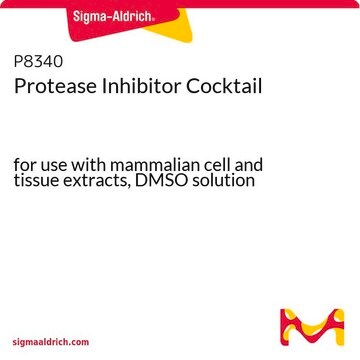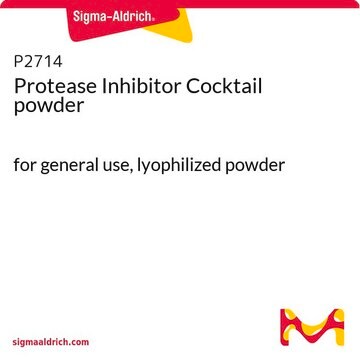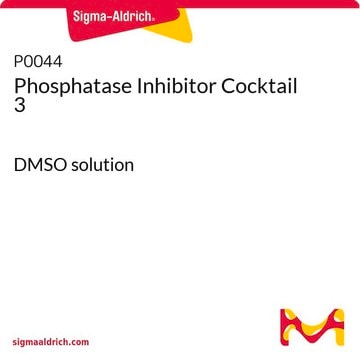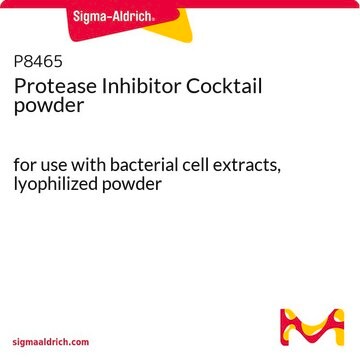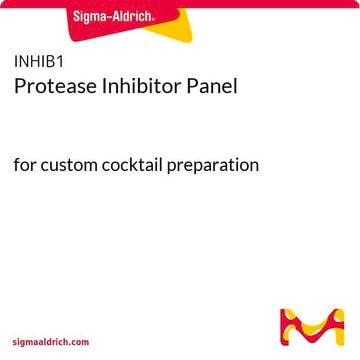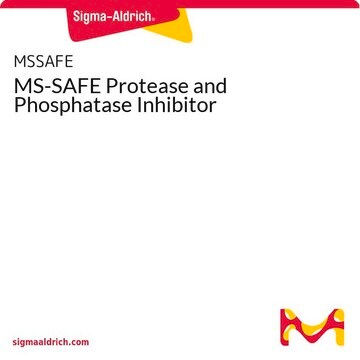P1860
Protease Inhibitor Cocktail
DMSO solution, for the inhibition of serine, cysteine, aspartic proteases and aminopeptidases, for use in tissue culture media, DMSO solution
Sinónimos:
Protease Inhibitor Solution, protease inhibitor
About This Item
Productos recomendados
Nombre del producto
Cóctel de inhibidores de proteasas, for use in tissue culture media, DMSO solution
Nivel de calidad
Formulario
DMSO solution
solubilidad
water: soluble
Condiciones de envío
dry ice
temp. de almacenamiento
−20°C
¿Está buscando productos similares? Visita Guía de comparación de productos
Categorías relacionadas
Descripción general
A431, CHO, COS, HepG2, and HeLa adherent cell lines
Jurkat and HL-60 cell lines grown in suspension
Especificidad
Aplicación
- as a supplement in supernatants and lysates for ex vivo infection experiments using human precision-cut lung slices (PCLS)
- to inhibit proteolysis by trypsin to prove that proteolysis is responsible for restoration of catalysis of corona-inhibited nanozymes
- in trypsin solution for trypsin-inhibited studies
- as a component in radioimmunoprecipitation assay (RIPA) buffer to lyse leukocytes for western blot
Acciones bioquímicas o fisiológicas
Características y beneficios
- Broad specificity
- Non-toxic: After 48 hours exposure, the product is non-toxic to adherent cell lines A431, CHO, COS, HepG2 and HeLa; and to Jurkat and HL-60 cell lines grown in suspension.
- Contains no metal chelators: Ensures compatibility with downstream applications
- Convenient packaging: 1 mL in glass bottle
- Easy to use: Use at a dilution of 1:200 or more in tissue culture media to prevent proteolytic degradation of secreted proteins.
Componentes
Bestatin
E-64
Leupeptin
Pepstatin A
Precaución
Cantidad
Forma física
Otras notas
Producto relacionado
Código de clase de almacenamiento
10 - Combustible liquids
Clase de riesgo para el agua (WGK)
WGK 1
Punto de inflamabilidad (°F)
188.6 °F
Punto de inflamabilidad (°C)
87 °C
Elija entre una de las versiones más recientes:
Certificados de análisis (COA)
¿No ve la versión correcta?
Si necesita una versión concreta, puede buscar un certificado específico por el número de lote.
¿Ya tiene este producto?
Encuentre la documentación para los productos que ha comprado recientemente en la Biblioteca de documentos.
Los clientes también vieron
Artículos
While aprotinin and bovine pancreatic trypsin inhibitor (BPTI) are the same protein sequence, the term aprotinin is typically used when describing the protein derived from bovine lung.
Contenido relacionado
Select different protease inhibitor types based on your needs to prevent protein degradation during isolation and characterization and safeguard proteins in sample prep.
Select different protease inhibitor types based on your needs to prevent protein degradation during isolation and characterization and safeguard proteins in sample prep.
Select different protease inhibitor types based on your needs to prevent protein degradation during isolation and characterization and safeguard proteins in sample prep.
Select different protease inhibitor types based on your needs to prevent protein degradation during isolation and characterization and safeguard proteins in sample prep.
Nuestro equipo de científicos tiene experiencia en todas las áreas de investigación: Ciencias de la vida, Ciencia de los materiales, Síntesis química, Cromatografía, Analítica y muchas otras.
Póngase en contacto con el Servicio técnico